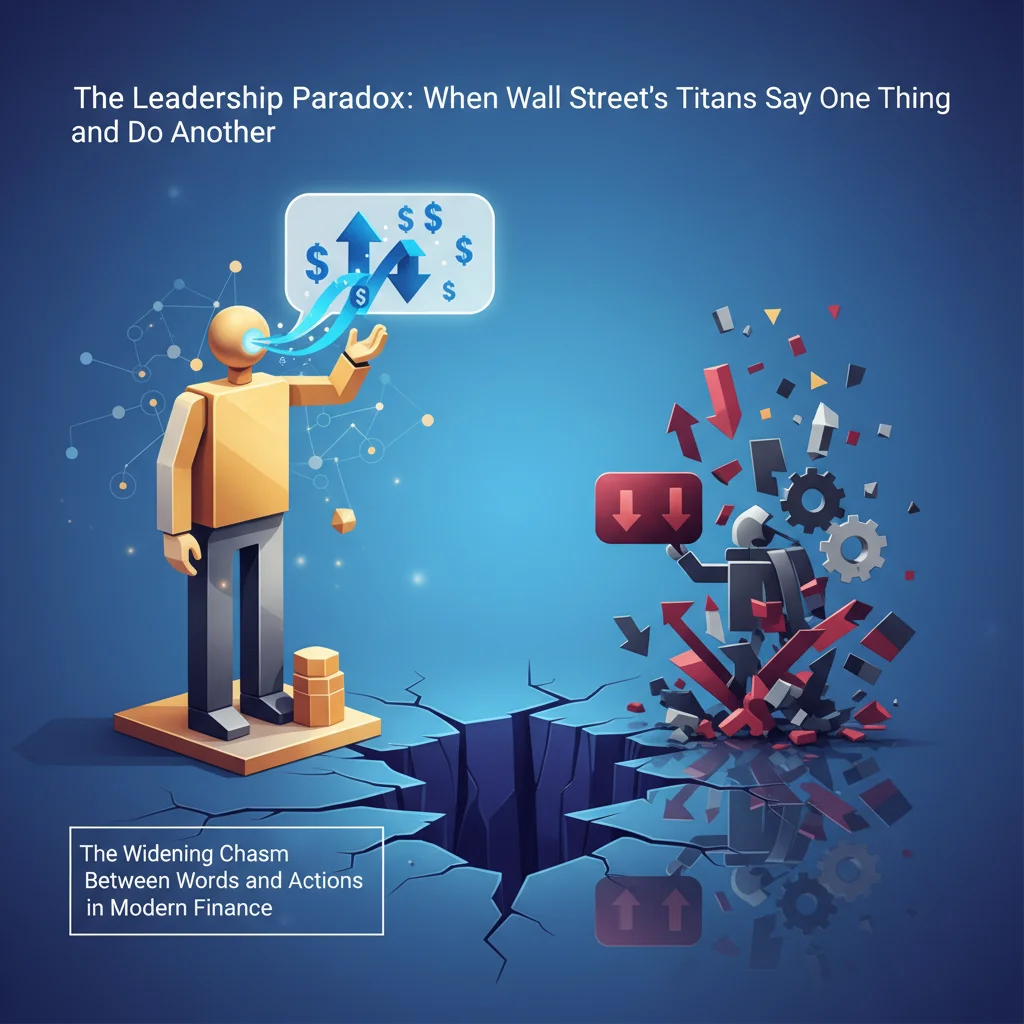
The Leadership Paradox: When Wall Street’s Titans Say One Thing and Do Another
The Widening Chasm Between Words and Actions in Modern Finance
In the world of high-stakes finance, leadership is more than just steering a company toward profitability. It’s about shaping market sentiment, influencing global economic policy, and building trust with investors, employees, and the public. The words of a CEO from a powerhouse like JPMorgan Chase or BlackRock can move markets and define entire investment trends. But what happens when those words seem to stand in stark contrast to their actions? This growing disconnect, a modern form of corporate cognitive dissonance, is becoming a defining challenge of our time, raising critical questions about integrity, strategy, and the future of the financial industry.
A recent letter to the Financial Times by Jonathan Hakim succinctly highlighted this phenomenon by pointing to three prominent figures: JPMorgan’s Jamie Dimon, BlackRock’s Larry Fink, and Australian property developer Tim Gurner. Each, in their own way, has made public statements that appear misaligned with their company’s strategies or reveal a profound disconnect with the very people their businesses are meant to serve. This isn’t just about isolated gaffes; it’s a pattern that signals deeper complexities and contradictions at the heart of the global economy. By dissecting these cases, we can uncover crucial insights into the evolving landscapes of financial technology, sustainable investing, and the delicate balance of capital and labor.
Case Study 1: Jamie Dimon and the Bitcoin Paradox
Jamie Dimon, the formidable CEO of JPMorgan Chase, has never minced words about his disdain for Bitcoin. He has famously labeled it a “fraud,” worse than the 17th-century tulip bulb mania, and more recently dismissed it as a “pet rock.” His public stance is clear: he sees decentralized, non-state cryptocurrencies as speculative, volatile assets used primarily for illicit activities, with no intrinsic value. For many investors, this message from the head of America’s largest bank is a powerful deterrent.
The Blockchain Reality at JPMorgan
Yet, while Dimon publicly disparages Bitcoin, JPMorgan has quietly become a titan in the underlying technology: blockchain. The bank’s actions paint a picture not of rejection, but of strategic adoption. Their Onyx Digital Assets platform is a blockchain-based network that processes billions of dollars in daily transactions, including short-term loans. JPM Coin, a permissioned, dollar-pegged digital token, allows institutional clients to transfer value instantaneously across the globe, streamlining a process that once took days.
This isn’t a contradiction; it’s a crucial distinction. Dimon separates the speculative asset (Bitcoin) from the revolutionary technology (blockchain). His critique is aimed at the unregulated, decentralized “wild west” of crypto trading. His bank’s strategy, however, is to harness the power of distributed ledger technology in a controlled, regulated, and institutional environment. For JPMorgan, blockchain isn’t about creating a new form of money to rival the dollar; it’s about building a more efficient and secure infrastructure for the existing financial system. This dual approach allows the bank to innovate within the burgeoning world of fintech while publicly maintaining a conservative, risk-averse posture that reassures regulators and traditional investors.
The Trillion-Dollar Handshake: Decoding the High-Stakes Intersection of Geopolitics and Finance
Case Study 2: Larry Fink and the ESG Conundrum
For several years, Larry Fink, CEO of the world’s largest asset manager, BlackRock, was the undisputed champion of ESG (Environmental, Social, and Governance) investing. His influential annual letters to CEOs urged companies to consider their impact on the planet and society, arguing that “climate risk is investment risk.” Fink positioned BlackRock as a leader in the movement toward a more sustainable economy, a stance that attracted trillions of dollars from investors eager to align their portfolios with their values.
Navigating the Crosswinds of Profit and Politics
The reality, however, is far more complex. As a manager of nearly $10 trillion in assets, BlackRock is one of the world’s largest investors in fossil fuel companies. A 2023 report from Reclaim Finance noted that BlackRock held over $100 billion in coal, oil, and gas assets, making its ESG proclamations ring hollow for many climate activists (source). Critics accuse the firm of “greenwashing”—using ESG as a marketing tool while continuing to profit from environmentally damaging industries.
Fink’s position is a delicate balancing act. On one hand, he must respond to growing client demand for sustainable options. On the other, his primary fiduciary duty is to maximize returns for all his clients, many of whom are invested in broad market index funds that inherently include energy giants. Recently, facing intense political backlash in the U.S. from both sides of the aisle, Fink has noticeably softened his rhetoric, even stating he has stopped using the “weaponized” term ESG. This pivot highlights the immense challenge of implementing a universal ESG framework in a politically polarized world where the definition of “social good” is fiercely debated. It demonstrates that for a financial behemoth, idealistic pronouncements must eventually contend with the pragmatic, and often messy, realities of the global stock market.
To better understand these conflicting positions, the following table breaks down the public statements versus the corporate actions of these financial leaders.
| Leader & Company | Public Stance (“What They Say”) | Corporate Action (“What They Do”) | The Underlying Nuance |
|---|---|---|---|
| Jamie Dimon JPMorgan Chase |
Bitcoin is a “fraud” and a “pet rock” with no intrinsic value. | Invests heavily in blockchain technology, operating the Onyx Digital Assets platform and JPM Coin for institutional transactions. | Distinguishes between speculative cryptocurrencies and the underlying blockchain technology, which the bank sees as the future of financial infrastructure. |
| Larry Fink BlackRock |
Promotes ESG investing, stating that “climate risk is investment risk” and urging companies to pursue sustainable goals. | Remains one of the world’s largest investors in fossil fuel companies, with massive holdings in oil, gas, and coal. | Balances fiduciary duty to maximize returns for all clients with growing demand for ESG, while navigating intense political pressure. |
| Tim Gurner Gurner Group |
Called for a 40-50% rise in unemployment to “kill arrogance” in the workforce and restore productivity. | Operates a luxury property development business that relies on a healthy economy and consumer purchasing power. | Reveals a stark disconnect between the executive perspective on labor productivity and the economic reality that mass unemployment would devastate the economy. |
Hollywood's New Kingmakers: Inside the Saudi-Backed Bid to Forge a Media Supergiant
Case Study 3: Tim Gurner and the Labor Market Disconnect
While not a Wall Street figure, Australian property mogul Tim Gurner’s comments at a business summit sent shockwaves through the global labor discourse. He stated that unemployment needed to rise by “40 to 50 percent” to curb worker “arrogance” and shift the balance of power back to employers. “We need to see pain in the economy,” he declared, lamenting a perceived decline in productivity since the pandemic (source).
A Failure to Read the Room—And the Economy
Gurner’s statement was widely condemned as callous and economically illiterate. A 50% increase from Australia’s then-3.7% unemployment rate would mean hundreds of thousands of lost jobs, a devastating blow to consumer spending, and a likely recession—all of which would cripple the very property market his business depends on. His comments encapsulated a profound disconnect between a segment of the executive class and the realities faced by the modern workforce.
This incident goes beyond a simple PR blunder. It taps into the central tensions of the post-pandemic economics: the “Great Resignation,” the push for remote work, and a renewed focus on work-life balance. Many workers, after facing the mortality and instability of a global pandemic, are re-evaluating their relationship with their jobs. Gurner’s perspective, which views labor as a commodity to be disciplined through economic hardship, is a throwback to an older, more adversarial model of capitalism. It ignores the fact that a skilled, motivated, and financially secure workforce is the primary engine of economic growth and a key driver of demand in every sector, from banking to real estate.
Beyond the Headlines: The Epstein Files and the New Era of Financial Accountability
Conclusion: The High Price of Dissonance
The cases of Dimon, Fink, and Gurner are more than just anecdotes; they are windows into the complex, often contradictory, world of modern leadership. Jamie Dimon’s stance reveals a pragmatic separation of speculative hype from transformative technology. Larry Fink’s journey with ESG illustrates the monumental challenge of aligning idealistic goals with the fiduciary and political realities of managing trillions of dollars. And Tim Gurner’s outburst serves as a stark reminder of the dangerous chasm that can form between executive suites and the general workforce.
For investors, business leaders, and the general public, the lesson is clear: look past the headlines and scrutinize the actions. A leader’s words provide a narrative, but their company’s capital allocation, technological investments, and strategic pivots tell the real story. In an increasingly skeptical world, authenticity is the most valuable currency, and the gap between saying and doing has never been more consequential for the stability and trustworthiness of our global financial system.


